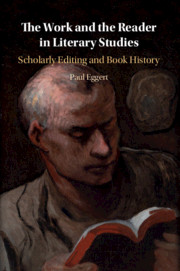Book contents
- The Work and the Reader in Literary Studies
- The Work and the Reader in Literary Studies
- Copyright page
- Dedication
- Contents
- Figures
- Preface
- Chapter 1 Introduction
- Chapter 2 Reviving the Work-Concept
- Chapter 3 The Digital Native Encounters the Printed Scholarly Edition Called Hamlet
- Chapter 4 The Reader-Oriented Scholarly Edition
- Chapter 5 Digital Editions
- Chapter 6 The Work, the Version and the Charles Harpur Critical Archive
- Chapter 7 Book History and Literary Study
- Chapter 8 Book History and Literary Study
- Chapter 9 Adaptation, Folklore and the Work
- Chapter 10 Conclusion
- Notes
- Bibliography
- Index
Chapter 9 - Adaptation, Folklore and the Work
The Ned Kelly Story
Published online by Cambridge University Press: 19 August 2019
- The Work and the Reader in Literary Studies
- The Work and the Reader in Literary Studies
- Copyright page
- Dedication
- Contents
- Figures
- Preface
- Chapter 1 Introduction
- Chapter 2 Reviving the Work-Concept
- Chapter 3 The Digital Native Encounters the Printed Scholarly Edition Called Hamlet
- Chapter 4 The Reader-Oriented Scholarly Edition
- Chapter 5 Digital Editions
- Chapter 6 The Work, the Version and the Charles Harpur Critical Archive
- Chapter 7 Book History and Literary Study
- Chapter 8 Book History and Literary Study
- Chapter 9 Adaptation, Folklore and the Work
- Chapter 10 Conclusion
- Notes
- Bibliography
- Index
Summary
Adaptation study reached a new high in the mid-2000s with Linda Hutcheon’s A Theory of Adaptations. She generates categories of adaptation to organise the scores of examples she discusses, but her book fails to develop a theory to underpin the study.
She finds hints of one in metaphors of ‘transcoding’, in Katherine Hayles’s use of the ‘rhizome’ model and in John Bryant’s idea of ‘reception-generated changes’. Only Bryant offers a viable lead, allowing her to propose a reception ‘continuum’. That is not enough.
Chapter 9 argues, rather, that adaptation depends upon the concept of the work. An adaptation becomes part of the original work’s after-life, just as the original work may be considered part of the adaptation’s prehistory. The adaptation establishes a new production–reception continuum or slider of its own, which either stops there because the new work is ignored or itself endows a newer adaptation. The latter takes on its own textual and cultural trajectory while remaining substantively linked to the first by virtue of its transformation of at least some subject matter.
Adaptations of the Ned Kelly bushranger story in folklore, stage, novel and screen serve as a test case.
Keywords
- Type
- Chapter
- Information
- The Work and the Reader in Literary StudiesScholarly Editing and Book History, pp. 155 - 166Publisher: Cambridge University PressPrint publication year: 2019

